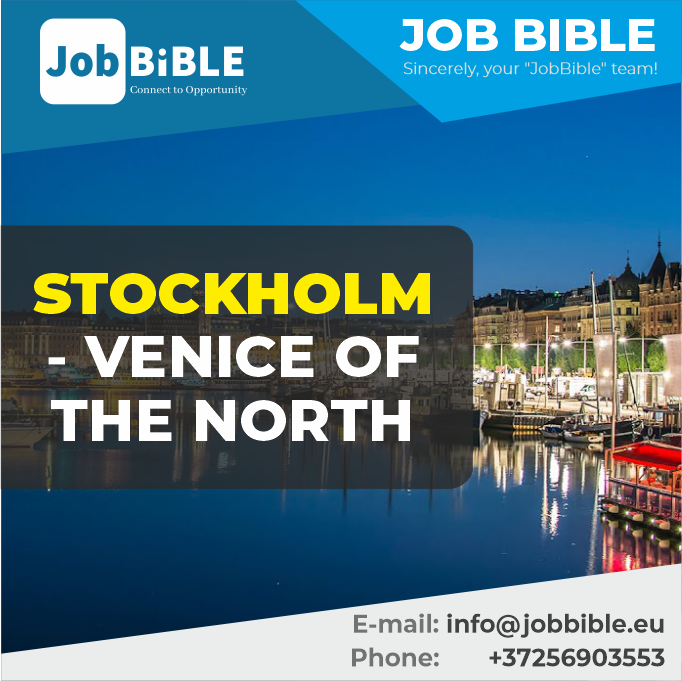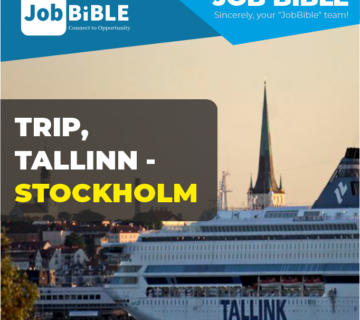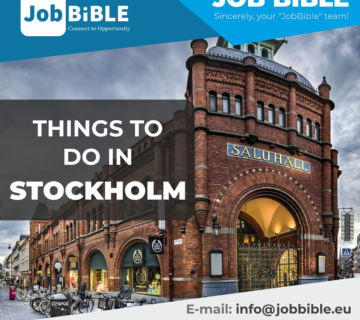This northern city, the capital of Sweden, built on fourteen islands that are a small part of an entire archipelago consisting of 24,000 islands, really resembles Venice. Stockholm is located in the Södermanland region, on the southeast coast of Sweden. It stretches along the shores of Lake Mälaren and on the islands of the strait connecting the lake with the Baltic Sea. The population of the city is about 740 thousand people, the vast majority of residents are Swedes, the most significant minority are Finns, and a large number of Iranians, Iraqis, Turks and immigrants from Somalia also live here. Most of the inhabitants profess Lutheranism.
The city was founded in 1252 by the Riksgrave Jarl Birger. Due to its important strategic position, Stockholm was initially destined to become a transit trade point. It became the capital of the state only in 1634, during the Thirty Years’ War. The Swedish kingdom as a centralized state was formed only in the middle of the XIII century, when the Volkung dynasty reigned here, descendants of Birger, who ruled in Sweden in 1248-1266, who was defeated in the Battle of the Neva in 1240 (according to legend, who received a wound on his face from the hands of Alexander Nevsky).
Then the development of trade with Danzig and Lübeck and the entry of Stockholm into the Hanseatic League led to the economic rise of the city. However, feudal fragmentation in the country and a hundred years of leapfrogging on the Swedish throne ended with Sweden’s subordination to Denmark. In 1523, Sweden finally threw off the yoke, and the rigsdag (an assembly of representatives of the country’s estates) elected the leader of the national liberation uprising of the Swedish nobleman Gustav Vasa as king. The most famous king of this dynasty was Gustav II Adolf, who became famous during the Thirty Years’ War and turned Sweden into a strong European power. At this time, the city began to develop rapidly as the economic and political center of the country. The monarchs of the Vasa dynasty left Stockholm baroque splendor – beautiful palaces, rich royal collections.
However, this dynasty has not managed to hold on to the Swedish throne until today. At the beginning of the XIX century in Sweden, the question of succession to the throne arose. With no heir, King Charles XIII of Sweden sought the advice of Emperor Napoleon. Carrying a letter from the king to Paris, the Swedish lieutenant appealed to one of the Napoleonic marshals, Jean Baptiste Jules Bernadotte, Prince pontecorvo, who became famous during the military campaigns in Belgium and Germany, with an offer to become heir to the throne in Sweden. Interestingly, in 1798, Bernadotte married Désirée Clary, the daughter of a Marseille ship-owner who had had an affair with Napoleon Bonaparte a few years earlier. Joseph Bonaparte, Napoleon’s older brother, was married to Désiré’s sister Julie, so Bernadotte turned out to be a relative of the Bonapartes.
In 1810, the Swedish Rigsdag elected Bernadotte as Swedish Crown Prince under the name Carl Johan, who changed his arrival in Stockholm from Catholicism to Protestantism. The Bernadotte dynasty still rules Sweden to this day. The 74th King of Sweden, Charles XVI Gustaf, is related to the Russian tsars, the English William the Conqueror, the Swedish Gustav Vasa, the Danish and Norwegian monarchs. Born in 1946, he studied at the University of Uppsala, and in 1972 at the Olympic Games in Munich he began an affair with the translator Silvia Sommerlat, half German, half Brazilian. He was the first of the direct heirs to the crown to change the existing policy of royal descent, choosing Cinderella as his wife. From this marriage were born two girls – the current heir to the throne Princess Victoria and Princess Madeleine – and Prince Carl Philip. The monarchy in Sweden has purely representative prerogatives, but remains part of the nation’s historical mentality.
The king is an ordinary man. This is once again confirmed by his gastronomic preferences. Like any Swede, he loves Swedish salad (these are lettuce leaves with pieces of cucumbers, tomatoes and sweet peppers), dishes from red fish (slices of salmon under white, mustard sauce or curry sauce or sprinkled with fragrant dill, which are always and everywhere, they are no exception at celebrations during the presentation of Nobel Prizes), cutlets from salmon, shrimp and crayfish, smoked eel and, of course, delicious meatballs. All of these – appetizers, hot and cold – can be part of a buffet (which, by the way, is already two hundred years old) or served as separate dishes.
Stockholm consists of water channels (almost the entire center can be viewed from a boat, but the fourteen islands of Stockholm are connected by bridges, so it is good to travel around the city on foot) and 30 percent of parks and green areas, and in Skansen, an open-air museum and zoo founded in 1891, you will see a whole collection of 160 wooden farms and houses from all over Sweden. On each farm live the most real animals – livestock, birds, dogs. This makes the park also a zoo. Stockholm has its first national park, eco-park. Construction here is allowed only if it does not cause damage to the environment, bio systems and cultural sites. Another park, Kungstradgarden, is ordinary, only it appeared already in the XV century. Then it was the royal “cabbage garden”, where fruits and vegetables were grown. Today it is an ordinary recreation park. In Stockholm, the air is very clean: the influence of the sea affects, which determines the temperature. In summer, it ranges from 20-25 ° C, in winter – from +2 to -7 ° C. They say that the water in the Stockholm canals is so clean that you can swim and fish even in the city center.
The night and restaurant life of the city is in full swing, which at first glance may seem uncharacteristic for this calm northern city. This is especially felt in the summer, because there are very bright long evenings, or short nights, which, in fact, is the same thing. It is believed that there are as many restaurants per capita as in Paris, and the club life can satisfy even the most demanding lover of entertainment. Sweden is the third largest exporter of pop music after the US and the UK. It all began with the success of the legendary ABBA in the 1970s, then Roxette and Cardigans gained worldwide popularity.
Fans of a more serious holiday in Stockholm are waiting for 150 museums and art galleries, the national theater Dramaten, the konserthuset concert hall; the Swedish capital hosts an international film festival every November. Ingmar Bergman and Greta Garbo grew up in Stockholm. Here lives Astrid Lindgren, the mother of Carlson, Pippi Longstocking and Emil from Leneberga. Her books have been translated into 76 languages and have sold more than 80 million copies worldwide. Born in 1907, she has lived in Stockholm since 1925. In 1997, Astrid Lindgren was named “Swede of the Year”.
The Stockholm Metro is something of a work of art. It is known as the “longest exhibition”, in the mid-fifties it was officially decided to decorate the metro stations, which designers and artists continue to do to this day. Of particular interest are the Central Station and Kungstradgerden stations. In 1998, Stockholm was declared the Capital of Culture of Europe. Every year in December, the whole world comes to Stockholm, as they say here, to present the Nobel Prize.
The Swedish capital can be divided into several parts. The oldest parts of the city – Gamla Stan and Stadsholmen – are located on the islands. In the districts of Norrmalm and Ostermalm the administrative, cultural and commercial life of the capital is concentrated, in Sodermalm and Vasastaden – restaurants and entertainment venues.
Stockholm has a lot of attractions. Let’s name just the most basic ones. Stockholm’s Old Town – Gamla Stan on the island of Riddarholmen (Knight’s Island) – is the heart of the northern Venice. Old buildings of the XVII and XVIII centuries have been preserved here, allowing you to feel the spirit of medieval Northern Europe. Walking day and night through the narrow streets of this quarter, which many centuries ago was a place of executions and at the same time grandiose royal celebrations, perhaps you will imagine yourself as a medieval knight or a beautiful lady. The Old Town is rich in its palaces – large (Wrangel Palace, Stenbokk Palace, Bundes palace) and small (once private palace of Axel Uxenstierna, Storkirkobrinken, Tessin Palace, Slottsbakken Palace). The Old Town is full of restaurants and cafés. On the busy old promenade of Sheppsbrunn, merchant houses of the XVII century have been preserved.
The island of Djurgerden, once a hunting ground for kings, located on the right side of the center, forms a green corner where fairs work on weekends and museums are open, including the famous Vasa Museum.
Kungliga Stottet, the royal palace, in the heart of the city on the island of Riddarholmen, was the residence of the Swedish monarchs until 1982. Today, King Charles XVI Gustaf receives ambassadors of other states here. This Baroque building was erected in 1692, its appearance has changed somewhat since then, but some parts of the medieval castle of the Three Crowns have survived to this day. The first to settle here in 1754 were King Adolf Frederick and his wife Queen Lovis Ulrika, one of whose sons was the future King Gustav III of Sweden. Today the palace is open to the public. Here you can see the halls of knightly orders, the hall of state assemblies, the royal treasury, the collection of antiques belonging to Gustav III, the royal chapel, banquet halls, as well as watch the changing of the guard.
Drottningholm Palace, the royal residence (with its Chinese pavilion, the court theatre and parks that have existed since the XVIII century), was the first in Sweden to be included in the UNESCO World Heritage List in 1991. The Museum of National Antiquities, i.e. a historical museum, shows the history of the country from prehistoric times, restores the culture of the Vikings, there is a magnificent collection of medieval wooden church sculpture.
There are many interesting museums in Stockholm, but truly the most unusual is the museum dedicated to the warship “Vasa”, since the whole museum is the ship itself. It was built in 1628 by order of the great king of the Vasa dynasty Gustavus Adolphus and, equipped with 64 guns, was supposed to become the most powerful galleon of its era. Vasa was built in Stockholm by Dutch shipbuilder Henrik Hiebertson. On the day of launch, thousands of citizens rushed to the embankment of the city. The ship gave a salute and a few minutes after the launch began to slowly sink into the water. Of the 150 people on board, about fifty died. The captain of the Vasa was taken into custody. King Gustavus Adolphus, who was at that time on the battlefield in Poland, learned about the tragedy only two weeks later. It turned out that the ship’s chief engineer Henrik Hiebertson had died a year before the Vasa was completed. His brother continued the work. The investigation found that the ship was well built, but its proportions were incorrectly observed. In addition, it was loaded with artillery, and the ballast, which was supposed to be a counterbalance to all this mass, was not enough. “Vasa” was found in 1956, raised from the bottom in 1959, and in April 1961 appeared in the port of Stockholm after a three-hundred-three-year break! In 1962, a temporary museum “Vasa” was opened, and in 1990 – a modern one, in which you can see the giant ship itself, and the objects and tools found on it.
Sweden is rich in tradition. Christmas is truly the grandest and longest holiday in Sweden. The four Sundays preceding Christmas last. That’s when the preparations for Christmas begin. Christmas markets open everywhere, where you can enjoy a variety of sweets, taste smoked sausages, reindeer meat, wash it all down with mulled wine (hot wine with spices appears during the feast of St. Lucia on December 13 and is sold on the streets throughout Christmas), as well as buy smoked salmon and honey for the festive table. At the city fairs, they sell all kinds of decorative arts. Skansen also opens a Christmas market. On Stockholm’s longest pedestrian street, Drottninggatan, shops compete to open sales.
On the Christmas buffet there are always smoked herring, boiled potatoes, meatballs, all kinds of sausages, Christmas ham, a dish called “Janson’s temptation” (potato gratan with pickled Baltic herring), lutfisk (boiled sea pike), rice pudding, cheese and bread, and from drinks – yulmust beer with salted biscuits. Another Christmas drink is grog (hot red wine with raisins and almonds). It is drunk both before and after a festive dinner. The Swedes attach particular importance to lighting during meals. These are, of course, candles of different shapes, sizes and colors. They create a special coziness in the house. Very popular in Sweden candlesticks in the form of large ice floes have become a national souvenir.
The center of the Swedish house at Christmas is the Christmas tree, which came to this country only at the beginning of the XX century. She, like us, is dressed up with tinsel, lights and all kinds of decorations. Gifts are also put under the tree and open in the evening, on Christmas Eve. On the morning of Christmas Eve, Swedes visit relatives and meet with friends. In the evening, when the Swedes sit down at the table, Santa is waiting in the house. Originally from Lapland, he came to Sweden and replaced the Christmas reindeer. The next morning, many Swedes go to listen to the morning Mass.
A few words about alcoholic beverages. Sweden has a “semi-dry” law. Alcohol is not sold on Friday, Saturday and Sunday. And all because the Swedes love to treat themselves to strong drinks. Ever since the Thirty Years’ War, during which Swedish troops invaded Germany, there is a German saying: “Drunk as seven Swedes.” Swedish alcohol history is said to come out of the Russo-Swedish Wars, after which vodka became a favorite drink of the Swedes. The pride of the Swedes is the famous “Absolute”, made of local grain, on local water, in bottles of local sand with a low iron content, with the design of an old pharmacy bottle, which has been produced since 1879.




